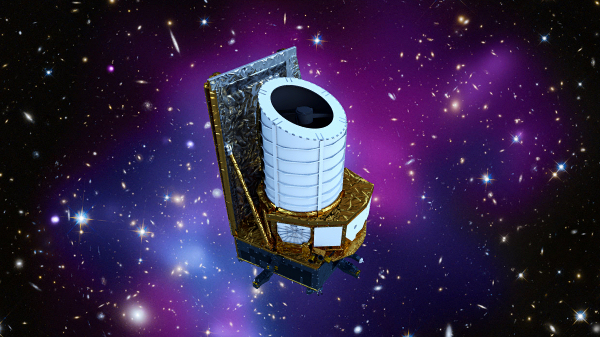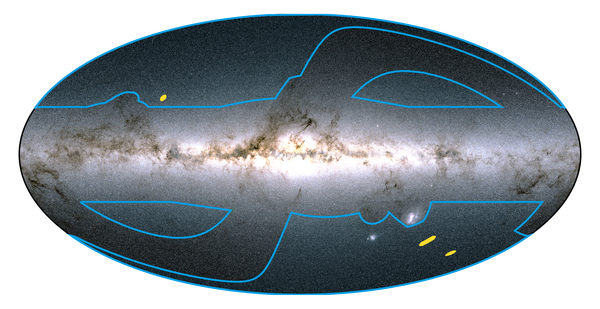Eine Raumsonde mit einem Teleskop wird zur Erforschung des Alls in selbiges geschossen. Die Raumsonde hat einen Namen: "Euclid". Was machen die geistesgroßen Journalisten derer von und zu Nullhirn? Sie sprechen es "juklid" aus.
Barbaren! Trottel! Analphabeten!
Euklid war ein Grieche. Der Arme würde sich im Grab umdrehen. Wenn, dann wird sein Name "e-u-klid" ausgesprochen, oder "e-o-klid". Im alten Griechisch also "e-u-klides" oder "e-o-klides".
https://sci.esa.int/documents/33220/36137/1567255801368-EUCLID_RB_Issue_1-1_2011-09-29HighQ.pdfhttps://sci.esa.int/web/euclid/-/summary[*quote*]
Currently, sci.esa.int is under review and not being updated. For the latest information and news from ESA science missions and scientific results, please visit esa.int. For in-depth technical information aimed at ESA's scientific communities, you may also wish to consult cosmos.esa.int.
ESA uses cookies to track visits to our website only, no personal information is collected.
→ European Space Agency
About Science & Technology
ESA
Science & Technology
euclid
ESA Science & Technology - Summary
Missions
Show All Missions
Mission Home
Summary
Fact Sheet
Mission Status
Science
Introduction
Mission science
What is dark matter?
What is dark energy?
What is gravitational lensing?
What are baryonic acoustic oscillations?
Legacy science (beyond cosmology)
Spacecraft
Overview
Payload Module
Telescope
VIS instrument
NISP instrument
Service Module
Mission Operations
Mission Operations
Resources
News Archive
Multimedia Gallery
Publication Archive
Calendar of Events
Journal archive
Services
Contact Us
RSS feed
Terms and Conditions
Summary
Euclid is a medium-class mission in ESA's Cosmic Vision programme to investigate the expansion of our Universe over the past ten billion years, probing cosmic epochs from before the expansion started to accelerate, all the way to the present. To this aim, Euclid will survey galaxies at a variety of distances from Earth, over an area of the sky covering more than 35 percent of the celestial sphere.
 https://cdn.sci.esa.int/documents/33220/35293/Euclid_artist_impression_600_summary1687223.jpg
https://cdn.sci.esa.int/documents/33220/35293/Euclid_artist_impression_600_summary1687223.jpgArtist's impression of Euclid. Credit: ESA/ATG medialab (spacecraft); NASA, ESA, CXC, C. Ma, H. Ebeling and E. Barrett (University of Hawaii/IfA), et al. and STScI (background)
Spacecraft, telescopes and instruments
The Euclid spacecraft will have a launch mass of around 2100 kg. It will be about 4.5 metres tall and 3.1 metres in 'diameter' (with appendages stowed). The nominal mission lifetime is six years.
The Euclid payload consists of a 1.2-m-aperture telescope with two instruments: the visual imager (VIS) and the near-infrared spectrometer and photometer (NISP).
Key questions
Euclid will help answering the following questions, among others:
What is the distribution of dark matter in the Universe?
What is the history of expansion of the Universe?
What does this tell us about the nature of dark energy? Does the dark energy equation of state evolve over time?
How do largescale structures form in the Universe?
How will Euclid tackle these questions?
Euclid is optimised for two primary cosmological probes:
Weak gravitational Lensing (WL): Weak lensing is a method to map the dark matter distribution and determine the effect of dark energy by measuring the distortions of galaxy images by mass inhomogeneities along the line-of-sight.
Baryonic Acoustic Oscillations (BAO): BAOs are wiggle patterns, imprinted in the clustering of galaxies on large scales, which provide a standard ruler to measure the expansion in the Universe and the acceleration caused by dark energy.
The Euclid survey
Euclid will survey the sky in a 'step-and-stare' mode: the telescope will point to a position in the sky, with imaging and spectroscopic measurements performed on an area of ~0.5 deg² around this position.
The sky coverage strategy is driven by the wide-survey requirement to cover 15 000 deg² of extragalactic sky (more than 35 percent of the celestial sphere) during the mission lifetime of 6 years. Additionally, a deep survey will be performed in three deep fields (40 deg² in total), reaching two magnitudes deeper than the wide survey.
 https://cdn.sci.esa.int/sci-images/content/images/2019/Euclid_EDF+EWS_all-sky_Gal_600w.jpg
https://cdn.sci.esa.int/sci-images/content/images/2019/Euclid_EDF+EWS_all-sky_Gal_600w.jpgThe Euclid wide and deep surveys. Credit: ESA/Gaia/DPAC; Euclid Consortium. Acknowledgment: Euclid Consortium Survey Group
Launch and orbit
Euclid will be launched from Europe's Spaceport in Kourou, French Guiana, on a Soyuz ST 2-1b launch vehicle that will place it onto a direct transfer orbit to its operational orbit.
The operational orbit – a large-amplitude (~ 106 km) halo orbit around the second Lagrange point of the Sun-Earth system (L2) – was selected because it offers optimum operating conditions for Euclid.
Synergies
Euclid will need additional data from ground-based telescopes, in order to improve photometric redshift determination, and Point-Spread Function (PSF) modelling for individual galaxies. Additional 4 band (u)griz photometry is considered, coming from the Pan-STARRS, Subaru and CFHT ground-based surveys. The volume of ground-based data will in fact be much larger than that of Euclid.
Last Update: 31 October 2019
1-Jul-2023 18:20 UT
Shortcut URL
https://sci.esa.int/s/8d5jvrAConnect with us
RSS
Youtube
Twitter
Flickr
Livestream
Subscribe
Follow ESA science
Twitter-2
Copyright 2000 - 2023 © European Space Agency. All rights reserved.
[*/quote*]

 Author
Topic: ARD Tagesschau ist für alles zu blöde (Read 103 times)
Author
Topic: ARD Tagesschau ist für alles zu blöde (Read 103 times)
